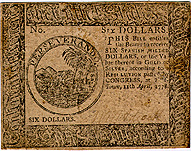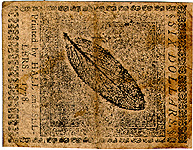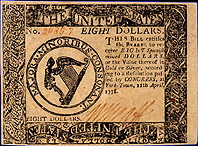Continental Currency
April 11, 1778 - Yorktown
Emissions totaling $25,000,000 payable in Spanish milled dollars, or the equivalent in gold or silver, was authorized by Continental Congress resolutions passed at Yorktown on April 11, May 22 and June 20, 1778 and resolutions passed at Philadelphia on July 30 and September 5, 1778. This issue is known as the Yorktown issue. Because of the extensive counterfeiting discovered in the May 20, 1777 issue this issue includes new engraved border cuts on the obverse and on the reverse newly redesigned letter type, typeset ornaments, border designs and new nature prints. Also, because of inflation denominations below $4 were eliminated and $20 and $40 notes were added. Even with the new designs there was extensive counterfeiting so that these bills were included in the January 2, 1779 recalled mentioned above in the May 20, 1777 issue. Also, this was the first issue which was not even accepted at face value by the Continental Congress at the date of issue. By April of 1778 the Congress officially valued the currency at $2.01 in Continental dollars for $1 in specie. The devaluation of continental currency had begun in most states as early as January 1777, by April of 1778 in some states the exchange was as high as $6 continental to $1 specie. Printed by Hall and Sellers who moved to Yorktown with the Congress from September 30,1777 - June 27, 1778. The paper, made at Ivy Mills in Chester County, Pennsylvania, contained blue fibers and mica flakes. Detector bills were printed on blue paper. Denominations include the: $4, $5, $6, $7, $8, $30 and $40.obv
 rev
rev
$6 Serial Number: [faded] CC 04/11/78
Signers: [faded], William Adcock.
Size: 72 x 95mm (front border design: 69 x 92.5mm; back border design: 68 x 90mm).
Comments: Numbered and signed in brown ink. The emblem on the front shows a beaver gnawing down a tree with the motto: "Perseverando" (By perseverance). The nature print on the back is of a sage leaf. Paper contains blue threads and mica flakes.
Provenance: EANA mail bid auction 1/13/96 lot 305. Purchased through the Robert H. Gore, Jr. Numismatic Endowment.
obv

$8 Serial Number: 24,657 CC 04/11/78
Signer: William Sheaff (in red) .
Size: not available.
Comments: Numbered and signed in light red ink. The emblem on the front shows a harp with thirteen strings with the motto: "Majora minoribus consonant" (The larger are in harmony with the smaller). The nature print on the back displays three sage leaves. No images of the back is available. The paper contains blue threads and mica flakes.
Courtesy of Early American Numismatic Auctions, Inc. Images used with permission from their on-line auction catalog for the auction of April 20, 1996, lot 397.